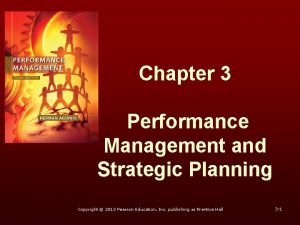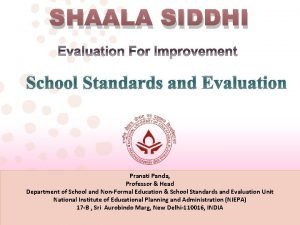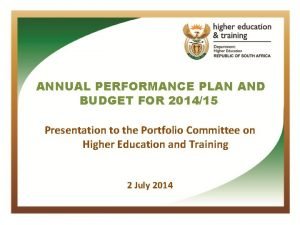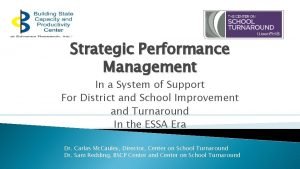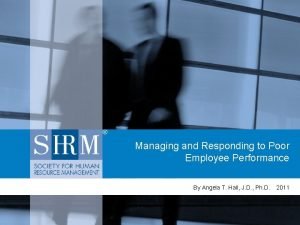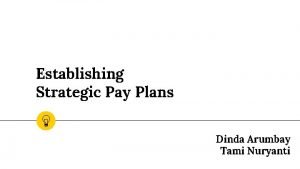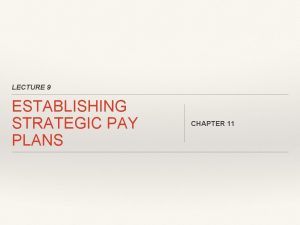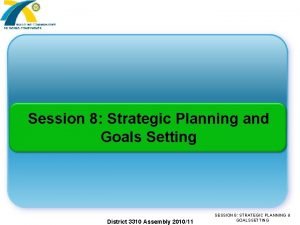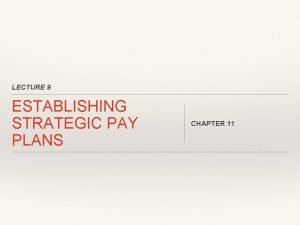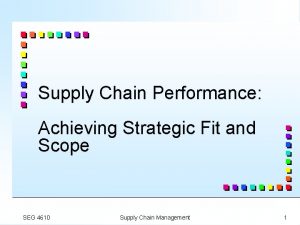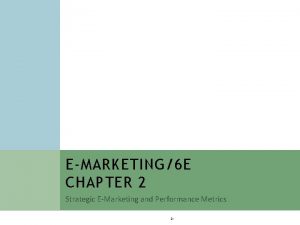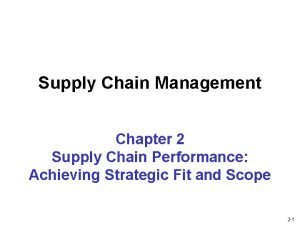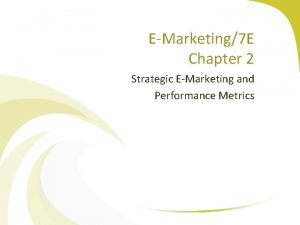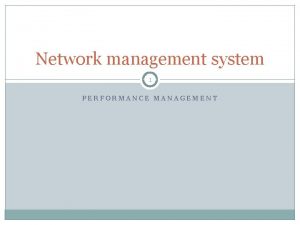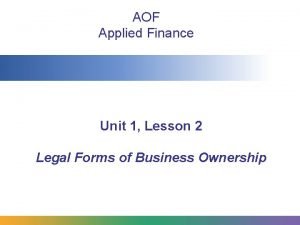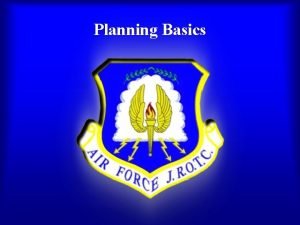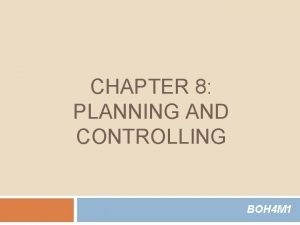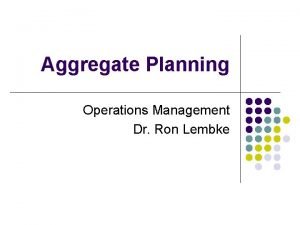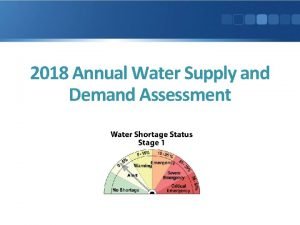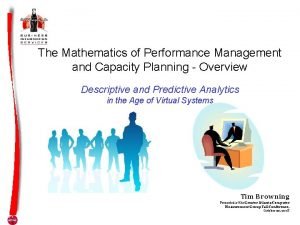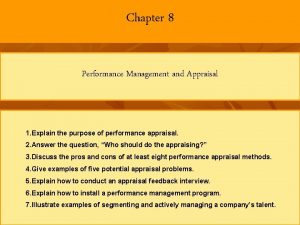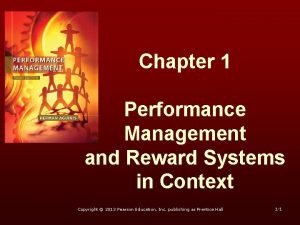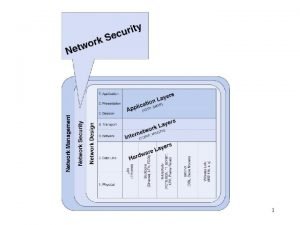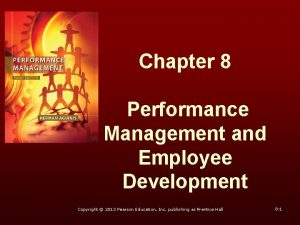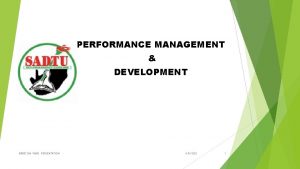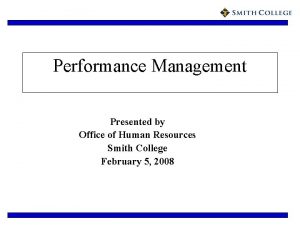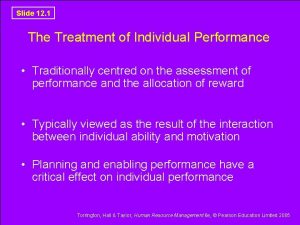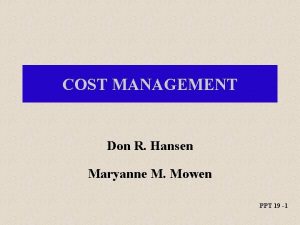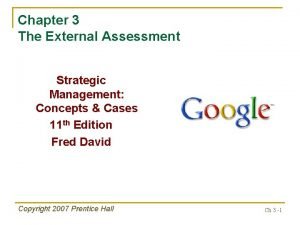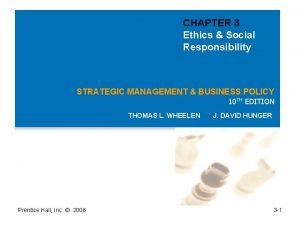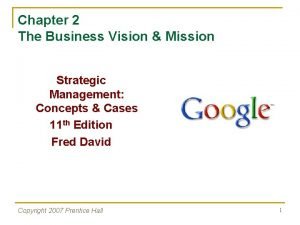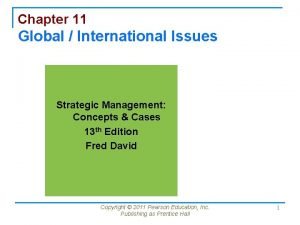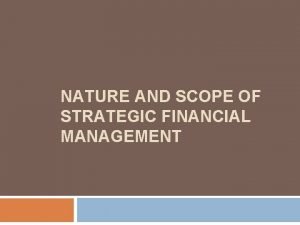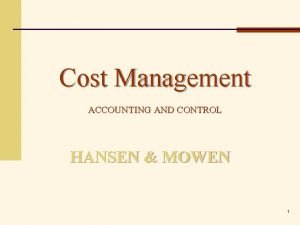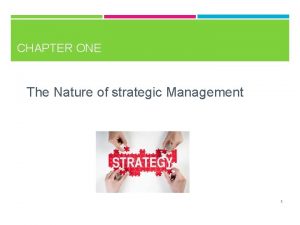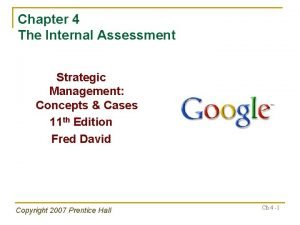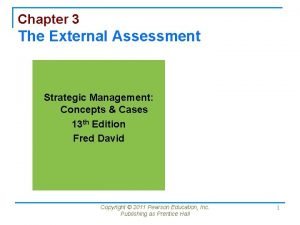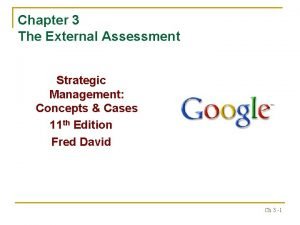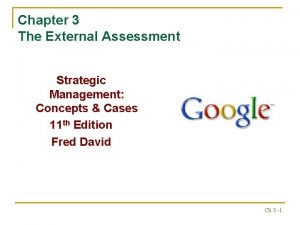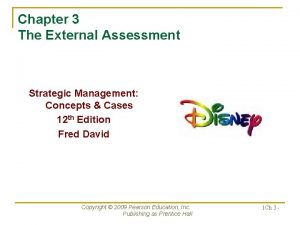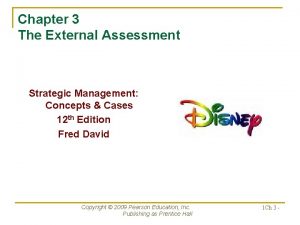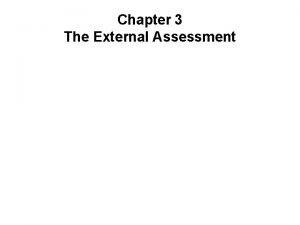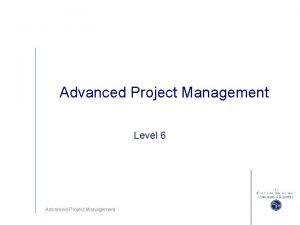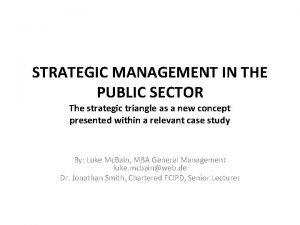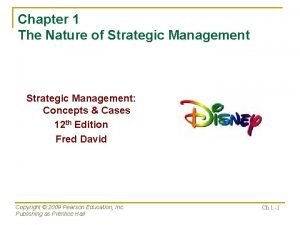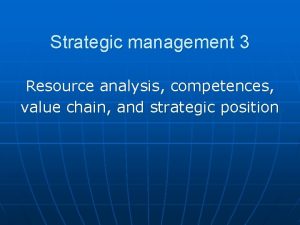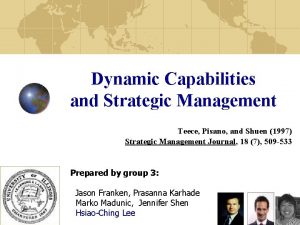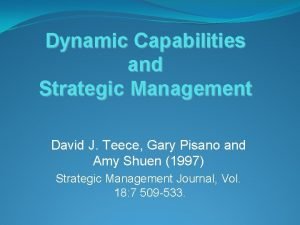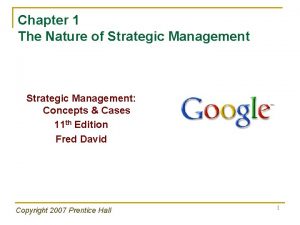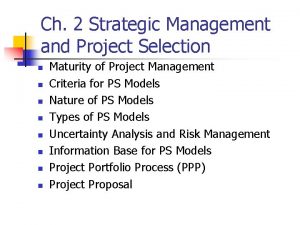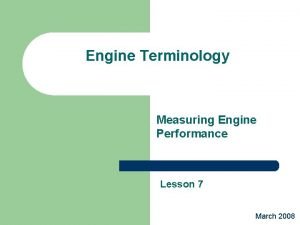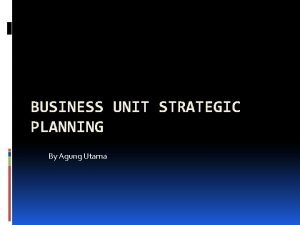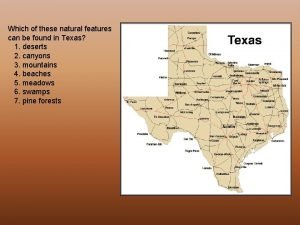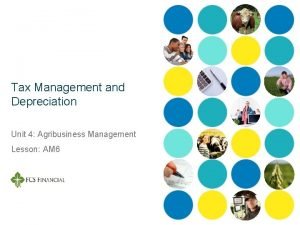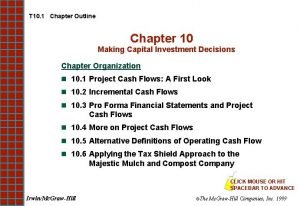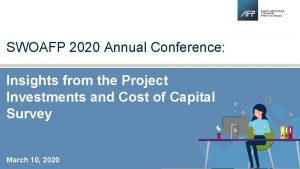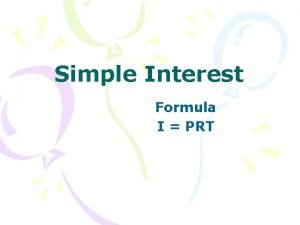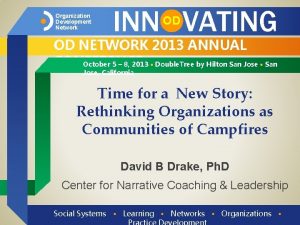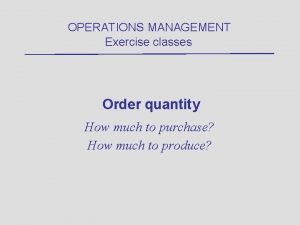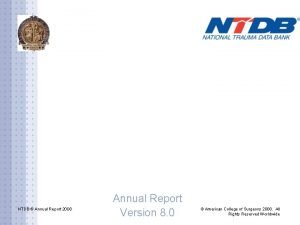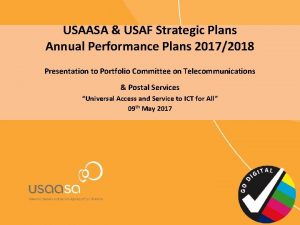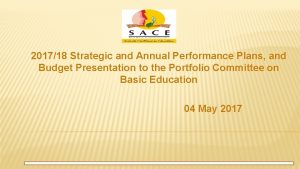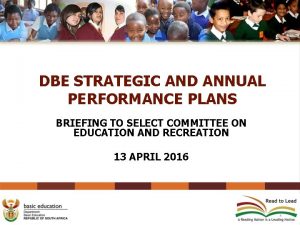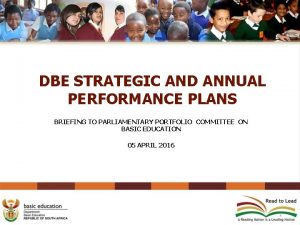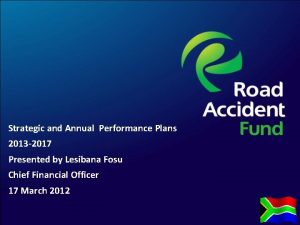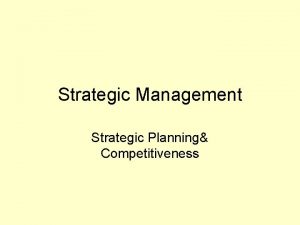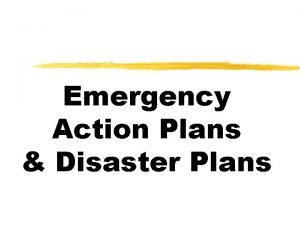Strategic and Annual Performance Plans Strategic Management Unit













































































































- Slides: 109

Strategic and Annual Performance Plans Strategic Management Unit I Governance, Risk & Compliance Branch I Office of the Director-General

Purpose To present the 2020 – 2025 Strategic Plan, 2020/21 Annual Performance Plan and Budget Vote of the Department of Public Works and Infrastructure to a Joint briefing of the Portfolio Committee on Public Works and Infrastructure and Select Committee on Transport, Public Service and Administration, Public Works and Infrastructure 2

Table of Contents 1. Contextual Background 2. Revised Framework and Format 3. The Strategic Plan 2020 – 2025 and APP 2020/21 4. External and Internal Environments 5. SP and APP Key Performance Indicators contributing to the Outcomes and Priorities 6. Budget Structure 3

Contextual Background 1

Contextual Background The State of the Nation Address (SONA) by the President on the 20 th of June 2019 reflected the reality of our people and set out the broad framework to respond to the challenges confronting the nation and articulated seven priorities aligned to the NDP and Medium-Term Strategic Framework (MTSF) namely: • • PRIORITY 1: Economic transformation and job creation PRIORITY 2: Education, skills and health PRIORITY 3: Consolidating the social wage through reliable and quality basic services PRIORITY 4: Spatial integration, human settlements and local government PRIORITY 5: Social cohesion and safe communities PRIORITY 6: Building a capable, ethical and developmental state PRIORITY 7: A better Africa and world. 5

Alignment with National Priorities 6

Revised Framework and Format 2

Revised Framework for Strategic And Annual Performance Plans (FSAPP) • The Department of Planning, Monitoring and Evaluation introduced the 2019 Revised Framework for Strategic and Annual Performance Plan that sets out the planning principles to inform the logic and content of the strategic plan, annual performance plan, annual operational plan and implementation programme plans, and the linkages between other short and medium term plans in government. • The result-based methodology is a requirement and must be highlighted in departmental planning documents. • The planning for women, children and people with disabilities must be reflected in the departmental planning documents. • Stakeholder consultation and alignment with implementing agencies (public entities) is also a key requirement. • It further provides the logic for the monitoring and evaluation of plans, as well as the utilisation of related reporting instruments and the results thereof at the different stages of the planning cycle. 8

The Strategic Plan 2020 – 2025 and APP 2020/21 3

Strategic Plan and Annual Performance Plan Format • The format of the DPW&I plan is in line with the revised Framework for Strategic and Annual Performance Plans, DPME 2019 as follows: Part A: Our Mandate Minister’s Foreword Accounting Officer Statement Official Sign-Off Constitutional Mandate Legislative and Policy Mandates Institutional Legislation, Policies and Strategies and governmentwide alignment over the Five Year Planning Period • Relevant Court Rulings • • • Part B: • Vision Our Strategic Focus • Mission • Values • External Situational Analysis (PESTLE) • Internal Situational Analysis (PESTLE) Part C: Measuring our performance • Institutional impact and outcome statements • Institutional impact and outcome indictors 10

DPW&I Integrated Planning Approach Impacts Strategic Plan Outcomes Annual Performance Plan • Logic Model and Theory of Change • - Research provide policy direction regarding the priorities for the sector spatial impact of the priorities standardisation of output indicators for a sector - • Theory of Change links outcomes and activities to explain HOW and WHY the desired change is expected to come about • Logic model graphically illustrate program components, and clearly identifying outcomes, inputs and activities • Performance measures (KPIs) Outputs Activities Operational Plan Inputs 11

Sector Planning Strategy Map 12

Constitutional Mandate • Constitutional Mandate Schedules 4, 5 and 6 of the Constitution Provide functional areas of concurrent National, Provincial and Local Government legislative competency. Section 25 of the Constitution This section covers matters relating to land expropriation. • Constitutional Imperative: Areas of Compliance Section 9 of the Constitution Requires state immovable assets to be accessible to persons with disabilities. Section 41 of the Constitution The Department has to observe the principles of good cooperative governance and intergovernmental relations. Section 114 (2) of the Constitution A provincial legislature must provide for mechanisms to ensure that all provincial executive organs in the province are accountable to it and to maintain oversight of the exercise of provincial executive authority in the province including the implementation of legislation, and any provincial organ of the state. Address skills development in a manner that accelerates the advancement of previously disadvantaged people, women and designated groups with particular emphasis on leaderships, as well as technical and management training. Procurement must be done in accordance with a system which is fair, equitable, transparent, competitive and cost-effective. 13 Section 195 and Section 197 of the Constitution Section 217 of the Constitution

DPWI Key Legislative Mandates The Government Aims to ensure competent immovable asset management in Immovable Asset National and Provincial Government in order to improve service Management Ac 19 of delivery. 2007 Infrastructure Aims to provide for the coordination of public infrastructure Development Act, development which is of significant economic or social 2014 (Act 23 of 2014) importance. Further, established the various PICC structures that enable the coordination, oversight and unblocking of strategic infrastructure projects and related investment Land Affairs Board Act, 1987 (Act 101 of 1987) Section 6: Provides for the function of the Land Affairs Board in relation to determinations of valuations for immovable assets under the custodian of the Department. The Council for the Built Environment Act, 2000 (Act 43 of 2000) Makes provision for the establishment of a juristic person known as the Council for the Built Environment, the composition, functions, powers, assets, rights, duties and financing of that Council and for matters connected thereto. 14

DPWI Key Legislative Mandates The Construction Industry Provides for the establishment of the Construction Industry Development Board (cidb), for the implementation of an Development Board Act, integrated strategy for the reconstruction, growth and 2000 (Act 38 of 2000) development of the construction industry and other matters connected thereto. Ensures that infrastructure projects are procured and delivered in accordance with cidb Prescripts. The Professional Council Organises the built environment professions to serve the Acts regulate the six Built imperatives of Government, including transformation, public Environment Professions protection, good governance, etc. (BEPs) Expropriation Act, 1975 (Act 63 of 1975) Section S 12 (1): Determines the basis of the compensation amount. State Land Disposal Act, 1961 (Act 48 of 1961) Provides for the disposal of certain state land for matters incidental thereto, and prohibits the acquisition of the state land by prescription. 15

Vision, Mission And Values WE PRIDE OURSELVES WITH THE FOLLOWING VALUES: PROFESSIONALISM: BY DEMONSTRATING A HIGH DEGREE OF SKILL, COMPETENCY AND CHARACTER. DEPENDABILITY: BY BEING TRUSTWORTHY AND RELIABLE IN THE SERVICES WE PROVIDE. INTEGRITY: BY CONSISTENTLY HONOURING OUR COMMITMENTS, UPHOLDING ETHICAL, HONEST BEHAVIOUR AND TRANSPARENT COMMUNICATION. RESPONSIVENESS: BY ANTICIPATING THE NEEDS OF THE CLIENTS AND THE CITIZENS WE SERVE. EFFICIENCY – BY STRIVING TOWARDS SIMPLIFIED WAYS OF DOING THINGS AND OPTIMIZE CLIENT’S MANDATE THUS CREATING MORE VALUE 16

Vision, Mission And Values Vision A trusted choice for innovative asset management and quality Infrastructure delivery for sustained economic growth. Mission To provide strategic direction and quality services that offer innovative asset management and pro-active socio-economic Infrastructure delivery and maintenance of public assets while protecting the environment and the cultural and historic heritage, safety in the working environment and safer communities towards sustainable development. 17

National Priorities DPWI Strategy Map Global Competitiveness (Region, Continent, Globe) Infrastructure-led Economic Growth Public. Entities Provinces Municipalities Private. Sector (PPP) Newand Emerging Development Partners (infrastructure Developmentand Investment) DPWI Impact ROLE-PLAYERS/STAKEHOLDERS National Departments Ease of doing Business (through infrastructure) Transformed Built Environment Productive Assets Co-ordinated Integrated Planning Optimised Job Opportunities Dignified Client Experience DPWI Outcomes International Stakeholders Sustainable Infrastructure Investment Resilient, Ethical and Capable DPWI 18

Policies and Strategies Supporting Outcomes A Resilient, Ethical and Capable DPWI Integrated Planning and Co-ordination • National anticorruption strategy • Organisational and Employee Performance Management Strategy • Retention Policy • Digital Transformation Strategy • Organisation-wide ICT Change Management Strategy • Sector-wide Monitoring and Evaluation Strategy • Stakeholder Value Management Strategy • Urban regeneration precinct planning • 3 smart cities programme • New City Initiative Sustainable Infrastructure Investment • Infrastructure Delivery Management System • Infrastructure Development Strategy and Plan • 30 -40 year National Infrastructure Plan, Strategic Infrastructure Projects (SIPs) • Project Performance and Monitoring System • Infrastructure Modular Strategy and costed Design Manual Productive Assets • Green Building Policy • Utilisation Optimisation Strategy • Disposal Strategy • Cost Containment Strategy • Return on Investment Optimisation Strategy • Resource Efficiency Interventions and Capacity Building Strategy • Acquisition Strategy • Backlog and Maintenance Strategy 19

Policies and Strategies Supporting Outcomes Transformed Built Environment • Address the Spatial Transformation Agenda • Built Environment Professions Development Strategy • SCM Prescripts and Procurement Policy • Contractor Development Programme • Aggressive implementation of Contractor Development/ Incubator Programme • Aggressive Implementation of Property Management Empowerment Policy Optimised Job Opportunities • Procurement Framework • EPWP Coordination Strategy • Mainstreaming of EPWP across the built environment sector, in all three spheres of government. Dignified Client Experience • Value Management Strategy • Business Processes, Standard Operating Procedures (So. Ps) and Service Delivery Standards 20

The Theory of Change • By aligning people to processes and systems to drive organisational performance, we create a new effective and efficient culture that delivers ethically in a developmental state • By co-ordinating and incorporating stakeholder needs into infrastructure and spatial planning where government service delivery is enhanced Resilient, Capable and Ethical DPWI Integrated Planning & Co-ordination • By delivering sustainable infrastructure and creating a growing an economy through infrastructure investment as means to stimulate an inclusive growing industry Productive Assets Infrastructure Investment • By delivering sustainable services where stakeholders are satisfied • By creating job opportunities and sustainable jobs for better living conditions Dignified Client Experience Optimised Job Opportunities • By managing the asset portfolio with a productive strategic intent to enable better Gross Fixed • By transforming the built industry for mutual and sustainable socio-economic benefit Transformed Built Environment Infrastructure-led Economic Growth 21

External and Internal Environments 4

External Environment Other factors considered Measures Unemployment Growth Baseline 1 Needed Proposed Target realistic Target 2024 target 2024 NDP 2030 Formal rate 27. 6% 14. 0% 19. 0% 6. 0% GDP 0. 8% 3. 5% 2. 5% 5. 4% Gini Coefficient 0. 68 0. 63 0. 66 0. 60 Food Poverty 24. 7% 12% 20% 0. 0% Lower Bound 39. 8% 20% 28% 0. 0% 18% 23% 30% Inequality Poverty Investment % of GDP Global Competitiveness Ease of doing business Labour Market Public Infrastructure spending • Vacant land across South Africa • Construction Sector • • 23

Internal Environment • • • Budget Trends Capacity and Strategies for Employment IT Architecture Implementation of the IDMS Governance Structures Performance trends 24

SP and APP Key Performance Indicators contributing to the Outcomes and Priorities 5

Impact Statement Impact Infrastructure-led Economic Growth Impact Statement Infrastructure investment and services to lead economic growth through potential simultaneity between infrastructure and output. The added Infrastructure role allows DPWI, alongside the Infrastructure Investment Office in the Presidency to structure the country’s Infrastructure-led Economic Growth under a single point of entry where the overall National Infrastructure Plan for South Africa is defined and the pipeline of bankable projects are focused within a new methodology 26

Impact: Infrastructure–led Economic Growth SP Outcome 1: Resilient, Ethical and Capable DPWI Outcome: A resilient, ethical and capable DPWI Outcome Statement: Reinvent the organisation to be Agile, Ethical and Compliant, where everyone wants to work, with improved efficiencies achieved through seamless automated processes. Sub-outcomes Effective Governance Empowered Employees Agile Technology and Systems Accountable Performance 27

Priority Focus Areas Agile Responsive, characterised by the division of tasks into short phases of work and frequent reassessment and adaptation of plans. Ethical Ethics refers to the ethical values and principles applied during the Department's activities, how decisions are made and the relationship between the Department and its stakeholders. Compliant Adhering to laws, binding and non-binding regulations, Departmental policies and procedures, local and international best practice principles of ethics and corporate governance. Capable Ability to achieve efficiently whatever one has to do; to be competent. 28

SP Outcome 1: A Resilient, Ethical and Capable DPWI Outcome Indicator Outcome 1: A Balanced Scorecard Resilient, Ethical and Capable DPWI Enablers/Operational Plans Digitisation Aligned Organisational and Employee performance management system Functional HR Committee and Forum Aligned Recruitment Plan HRD Plan An Integrated ERP System Six pillars of the National anti-corruption strategy (NACS) Lifestyle audits Staff retention Aligned Skills Development Plan Unqualified audit as a Key Result Area for all SMS agreements Legislative Mandate 29

SP Outcome 1: A Resilient, Ethical and Capable DPWI PRIORITY 1: A CAPABLE, ETHICAL AND DEVELOPMENTAL STATE Priority MTSF / MDA SP Indicator 5 -year target MDA: Ensure functionality of ethics structures and adequate capacity MDA: Percentage elimination of wasteful and fruitless expenditure in public sector institutions MDA: Percentage reduction of irregular expenditure in public sector institutions MDA: Percentage reduction of qualified audits in the public sector MDA: Percentage resolution of reported incidents of corruption in the government MTSF & MDA: Business Processes Modernisation Programme in the public sector approved (2020) and implemented (2023) Balanced Scorecard The indicator maps an organisation's outcomes into performance metrics that seek to provide relevant feedback as to how well the strategic plan is executing so that adjustments can be made as necessary. It gives a balanced view of performance aligned to the vision and strategy. APP indicator 3 -year target 1. 1 Ethics and Fraud Perception Rating (%) 61 -80% 1. 2 Compliance Rate 81 -100% 1. 3 Performance Information Level 81 -100% (%) 81 -100% 1. 4 Financial Performance Level (%) 100% 1. 5 Vacancy Rate (%) 10 % 1. 6 Designated groups in SMS level Women: 40% in the Department (Women and PWD: 2% PWD) 1. 7 Business Process Automation (%) 100% 1. 8 Number of business solutions for digitisation 1 6. 1 Percentage Financial Performance Level 100% annually 30

Quarterly Targets OUTPUT INDICATOR ANNUAL TARGET Q 1 Q 2 Q 3 Q 4 1. 1 Ethics and Fraud Perception Rating (41 -60%) Average rating N/A N/A 41 -60% 1. 2 Compliance Rate (41 -60%) Average level of Compliance N/A N/A 41 -60% 61%-80% 61%-80% 1. 4 Percentage Financial Performance Level 1. 5 Percentage Vacancy Rate 100% 27% 53% 87% 100% 12% 12% 12% 1. 6 Designated groups in SMS level in the Department (Women and PWD) Women: 40% PWD: 2% 1. 7 Percentage Business Process Automation 1. 8 Number of business solutions for digitisation 100% N/A N/A 100% 1 N/A N/A 1 1. 3 Percentage Performance Information Level Women: 40% PWD: 2% 31

Sub-outcomes Impact: Infrastructure-led Economic Growth SP Outcome 2: Integrated Planning and Co-ordination Outcome Statement: Integrated planning and coordination for inclusive economic growth and structural transformation resulting in socio economic returns and development. Informed government planning Identified Inter-governmental Requirements 32

Priority Focus Areas Integrated spatial planning Refers to the modern urban development strategies and approaches used to design and plan the distribution of people, facilities, infrastructure, spaces and activities in set regions. Co-ordinated. Integrated Ensures the participation of all stakeholders and sector departments. Its objective is to planning examine all economic, social, and environmental costs and benefits, in order to determine most appropriate option and to plan a suitable course of action. Delivery of government Correct planning through which public services are delivered to the public by local or services national government departments such as education, and health services. Co-ordination of Infrastructure development within all spheres of government. 33

SP Outcome 2: Integrated Planning and Co-ordination Outcome Indicator Outcome 2: Integrated Planning and Co-ordination National Infrastructure Plan Developed Spatial Justice Enablers/Operational Plans Programme management system. An inventory of existing infrastructure. Well defined short, medium and long term sectoral infrastructure needs. Sufficient funding. Skilled capacity. Access to well-located and suitable land. Data and research. Policy development. Stakeholder Management Strategy. CT (video/teleconferencing facility). 34

SP Outcome 2: Integrated Planning and Co-ordination PRIORITY 5: SPATIAL INTEGRATION, HUMAN SETTLEMENTS AND LOCAL GOVERNMENT Priority MTSF / MDA % of approved land reform projects provided with post settlement support MDA: % joined-up plans Number of cities identified for re-design and refurbishment as Smart Cities (by March 2024) SP Indicator • National Infrastructur e Plan Developed 5 -year target • National APP indicator 3 -year target 2. 1 Number of infrastructure implementation plans Reviews 3 (1 per year) 8. 1 Number of design solutions completed for identified user departments 3 (1 per year) 4. 3 Number of cities identified for redesign and refurbishment as smart cities 3 cities refurbished Infrastruct ure Plan 2060 2. 2 Sector Performance Reviews 6 Developed (2 per year) (100%) 2. 4 Percentage of Implementation of 100% the Provincial Department of Public Works Capacity Building Programmes aligned to the Skills Pipeline Strategy 4. 4 Number of new cities planned and developed by 2024 35

Priority MTSF / MDA SP Indicator Priority 5: Cross PRIORITY 5: SPATIAL INTEGRATION, HUMAN Cutting SETTLEMENTS AND LOCAL GOVERNMENT SP Outcome 2: Integrated Planning and Co-ordination MTSF: Hectares (Ha) of Land redistributed or acquired and or allocated for agrarian transformation, industrial parks, human settlements and rural development. • Spatial Justice (Measures the 5 -year target • 60 -80% APP indicator 3 -year target 4. 5 Number of Revised SIPs Developed 54 (18 per year 4. 6 No of implementation plans finalised for Cabinet-approved projects 66 7. 1 Ha released from the DPWI portfolio for development of Infrastructure programs and socio economic objectives 45 195 ha MTSF & MDA: Number of government owned land parcels released towards spatial transformation and spatial justice 7. 2 Approved CAMP submitted to NT 3 MTSF and MDA: Percentage share by gender, age and disability of hectares (Ha) of land acquired, for redistribution, restitution, tenure reform and access to title deeds 10. 3 Number of land parcels vested (confirmation of ownership) 3 000 MDA No. of hectares of land acquired for redistribution, restitution and tenure reform extent of spatial infrastructure coverage achieved at the end of the five (5) year MTSF term in respect of user infrastructure programmes) (22 per year) (34 995, 5100) (1 per year) (1 000 per year) 36

Quarterly Targets Output Indicator Annual Target Q 1 Q 2 Q 3 Q 4 2. 1 Number of infrastructure implementation plans Reviews 2. 2 Sector Performance Reviews 2. 4 Percentage of Implementation of the Provincial Department of Public Works Capacity Building Programmes aligned to the Skills Pipeline Strategy 1 N/A N/A 1 2 75% N/A 1 N/A N/A 1 75% 8. 1 Number of design solutions completed for identified user departments 1 N/A N/A 1 4. 3 Number of cities identified for redesign and refurbishment as smart cities 1 N/A N/A 1 4. 5 Number of Revised SIPs Developed 18 N/A 18 4. 6 No of implementation plans finalised for Cabinet 22 -approved projects 34 995 7. 1 Ha released from the DPWI portfolio for development of Infrastructure programs and socio economic objectives 1 7. 2 Approved CAMP submitted to NT N/A N/A 22 N/A N/A 34 995 N/A 10. 3 Number of land parcels vested (confirmation of 100% ownership) (1 000) N/A 100% 37

Sub-outcomes Impact: Infrastructure-led Economic Growth SP Outcome 3: Sustainable Infrastructure Investment Outcome Statement: Sustainable and catalytic infrastructure investment for inclusive economic growth. Catalytic Growth Sustainable Growth 38

Priority Focus Areas Key Focus. Involves Areas developing GDP Growth roads, buildings, energy and water infrastructure with due consideration for economic, social and environmental growth. GFCF (Gross Fixed The effect of economic and social infrastructure, both on output and investment, is key to the role of government in both stimulating and enabling a conducive environment and Capital Formation) economic growth for South Africa. 39

SP Outcome 3: Sustainable Infrastructure Investment Outcome Indicator Outcome 3: Sustainable Infrastructure Investment Enablers/Operational Plans Infrastructure Investment as a percentage of GDP Certainty in policy for the country Private sector buy-in into government projects Funding availability CT (video/teleconferencing facility). 40

SP Outcome 3: Sustainable Infrastructure Investment Priority 5: Spatial Integration, Human Settlements and Local Government MTSF Priority 2: Economic Transformation and Job Creation Priority MTSF/MDA APP indicator 3 -year target MTSF & MDA: Infrastructure Fund established and operationalised 8. 5 Number of infrastructure projects completed 395 MTSF: National priority sectors grow Infrastructure contribution to GDP growth of Investment as a 3% and exports increase by 4% percentage of GDP 8. 2 Number of Projects completed within agreed construction period 345 MTSF & MDA: Infrastructure fund established SP Indicator 5 -year target (130, 135) (115 per year) 25% (Public Sector = 7% and Private Sector =18%) MTSF & MDA: Land agrarian reform fund established 41

Quarterly Targets OUTPUT INDICATOR ANNUAL TARGET Q 1 Q 2 Q 3 Q 4 8. 2 Number of Projects completed within agreed construction period 115 29 57 86 115 8. 5 Number of infrastructure projects completed 130 32 66 98 130 42

Sub-outcomes Impact: Infrastructure-led Economic Growth SP Outcome 4: Productive Assets Outcome: Productive Asset Outcome Statement: Optimise DPWI asset portfolio management to positively impact the economy, service delivery and the environment. Optimised use of the DPWI Asset Portfolio Sustainable Environment 43

Priority Focus Areas Optimised use of the DPWI Asset Portfolio Backlog & Maintenance – Improving state of the portfolio to better deliver Key Focus Areas services. Promote environmental sustainability through DPWI portfolio Utilisation Optimisation – Optimise portfolio utilisation to improve productivity, save costs, improve efficiencies and freeing up for other use. Cost Containment – Reducing holding costs, addressing exorbitant expenditure, and taking advantage of economies of scale. Disposals – Land Release (social or spatial priorities) / Letting / Bo. T / Permanent. ROI Optimisation – Surplus for utilisation and additional revenue Acquisitions – Build / Refurbish / Buy (Bo. T) / Lease Resource Efficiency – Renewable and clean energy generation, augmentation, solid waste management (recycling) and water purification. Green Building – Review of GBCSA Green Star Rating Tool and rollout of tools/ Building rating. Sustainability – Reduction / Saving Water & Energy consumption, Biodiversity management, Inclusion of sustainable Indigenous Knowledge Systems. Climate Change Mitigation- Greenhouse gas emissions reduction in Government buildings, Eco-labelling of materials. 44

SP Outcome 4: Productive Assets Outcome Indicator Outcome 4: Productive Assets Enablers/Operational Plans Productive Asset Index • • • Certainty in policy for the country Private sector buy-in into government projects Funding availability Maintenance Funding For the Department to take back its mandate FOSAD direction fourth revolution state buildings Green Index Score Green Building Policy 45

SP Outcome 4: Productive Assets PRIORITY 2: ECONOMIC TRANSFORMATION AND JOB CREATION Priority 3: EDUCATION, SKILLS AND HEALTH (contributing) Priority MTSF/MDA SP Indicator • MDA: Public assets managed effectively Productive Asset Index (Measures productivity of the DPWI Immovable Asset Portfolio against three (3) key impact areas namely: Service Delivery, Socio/Economic and Environmental Sustainability) 5 -year target APP indicator • 10% annual increase 3 -year target 9. 8 Percentage rental change through the letting out of small harbours and state coastal properties 20% annually 10. 2 Number of immovable assets physically verified to validate existence and assess condition 67 723 increase in revenue through rentals of state owned small harbour and coastal properties (29 562, 31 000, 7 161) 46

SP Outcome 4: Productive Assets PRIORITY 2: ECONOMIC TRANSFORMATION AND JOB CREATION Priority MTSF/MDA SP Indicator MTSF & MDA: Develop programme to strengthen asset management in the public sector • Productive Asset Index (Measures productivity of the DPWI Immovable Asset Portfolio against three (3) key impact areas namely: Service Delivery, Socio/Economic and Environmental Sustainability) 5 -year target APP indicator 3 -year target 10% annual increase 8. 4 Number of infrastructure sites handed over for construction 375 9. 1 Number of private leases reduced within the security cluster 33 9. 2 Savings realised on identified function specific private leases R 85 mil 9. 3 Percentage increase in revenue generation through letting of State-owned properties (excluding harbour properties) 20% 9. 4 Number of unutilised vacant state owned properties let out 240 (125 per year) (13, 10) (20 mil, 30 mil, 35 mil) (15%, 20%) (70, 100) 47

Quarterly Targets Output Indicator Annual Target Q 1 Q 2 Q 3 Q 4 8. 4 Number of infrastructure sites handed over for construction 125 32 64 93 125 - - - 13 - - - 20 - - - 15% - 35 9. 1 Number of private leases reduced within the security cluster 13 Private leases reduced within the security cluster 9. 2 Savings realised on identified function 20 million savings realised on identified specific private leases 9. 3 Percentage change in revenue 15% change in generation through letting of Staterevenue generation owned properties (excluding harbour through letting of properties) state-owned properties (excluding harbour properties) 70 number of 9. 4 Number of unutilised vacant state owned properties let out 48

SP Outcome 5: Transformed Built Environment Sub-Outcomes Impact: Infrastructure-led Economic Growth Outcome: Transformed Built Environment Outcome Statement: Contribute towards poverty alleviation and inclusive socioeconomic growth through targeted contracting, built environment transformation and skills development and achievement of spatial justice through the strategic use of DPWI public land building asset portfolio to effect spatial redress. Empowered Designated Groups Reduced Built Environment Skills Gap 49

Priority Focus Areas in terms of indicators, such as GDP, life expectancy, literacy and levels of Key Focus. Measured Areas Socio economic returns and development employment Inclusive economic growth Inclusive growth is economic growth that is distributed fairly across society and creates opportunities for all Skills Development Producing skills that are relevant to the demands of the Industry to address the unemployment rate. Closing the skills gap as per the demographic representation of the country Spatial transformation Refers to the process of transforming past policies designed to deny spatial and socioeconomic access and to prevent land property ownership on the basis of race, allow equal access to, irrespective of race, gender or class 50

SP Outcome 5: Transformed Built Environment Outcome Indicator Enablers/Operational Plans Outcome 5: TRANSFORMED BUILT ENVIRONMENT • Participation Rate Built Environment Skills Levels (%) Legislative Support to Built Environment Treasury Regulations. Property Management and Empowerment Policy. Skills Development ACT. The Construction Industry Development Board Act, 2000 (Act No. 38 of 2000. The Council for the Built Environment Act, 2000 (Act No. 37 of 2000) SPLUMA. Infrastructure investment towards GDP and unemployment evaluation study. Develop a coordinated broad base long term social and economic strategy for the built environment industry. Review and Implement and Monitoring Contractor Development Programme. Mandatory sub-contracting sub-contract 30% of all transactions that are worth R 30 million and above to Level 1&2 B-BBEE businesses. Implementation and Monitoring of PPR 2017. CBE and Professional Councils. Public Works and Infrastructure Institutions for the built environment. To develop technical capacity for Infrastructure Delivery, Maintenance and Management. Coordination of an enabling BE Skills Pipeline from basic education to professional level. Regulation of CIDB Standards to massify the skills development. Collaboration with Academic Institutions to influence the relevance of the Curriculum. Policy direction of Acts/Policy �Consensus and maximum participation on Bills 51

SP Outcome 5: Transformed Built Environment PRIORITY 2: ECONOMIC TRANSFORMATION AND JOB CREATION Priority MTSF / MDA MTSF & MDA: Proportion of youth, women and persons with disabilities SP Indicator • Participation Rate 5 -year target • 25% APP indicator 3 -year target 2. 3 Number of Beneficiaries participating in the DPWI’s skills Pipeline Intervention Programmes 3 992 (1395, 1257, 1340) 9. 5 Percentage of new leases awarded to black owned companies 35% (25%, 30%, 35%) 52

SP Outcome 5: Transformed Built Environment PRIORITY 1: A CAPABLE, ETHICAL AND DEVELOPMENTAL STATE PRIORITY 3: EDUCATION, SKILLS AND HEALTH Priority MTSF/MDA SP Indicator 5 -year target APP indicator MDA: Level of implementation of the NSP • Built • Environment Skills Levels (%) 35% 2. 4 Percentage of 75%, 100%, Implementation of the Provincial 100% Department of Public Works Capacity Building Programmes aligned to the Skills Pipeline Strategy • Legislative Support to Built Environment Expropriatio n Act Public Works and Infrastructu re Bill 4. 1 Expropriation Bill introduced in Parliament 1 4. 2 Public Works General Laws and Repeal Bill Developed 1 • • 3 -year target 53

Quarterly Targets Output Indicator 2. 3 Number of Beneficiaries participating in the DPWI’s skills Pipeline Intervention Programmes Annual Target 1 395 Q 1 N/A Q 2 N/A Q 3 N/A Q 4 1 395 9. 5 Percentage of new leases awarded to 25% of new leases black owned companies awarded to Black Owned companies 2. 4 Percentage of Implementation of the 75% N/A Provincial Department of Public Works Capacity Building Programmes aligned to the Skills Pipeline Strategy - - 25% N/A 75% 4. 1 Expropriation Bill introduced in 1 Parliament N/A N/A 1 4. 2 Public Works General Laws and 1 Repeal Bill Developed N/A N/A 1 54

Sub-outcomes Impact: Infrastructure-led Economic Growth SP Outcome 6: Optimised Job Opportunities Outcome Statement: Contribute towards poverty alleviation and unemployment reduction through provision of job opportunities Optimised Expanded Public Works Programme Sustained Job Opportunities 55

Priority Focus Areas Key Focus Areas Optimised Job opportunities are optimised through public sector spending Expanded Public on public employment initiatives resulting in poverty alleviation Works and reduction in unemployment. Programmes Sustainable jobs Jobs are optimised through the implementation of construction, through DPWI facilities management, and leasing, resulting in poverty Programmes alleviation. 56

SP Outcome 6: Optimised Job Opportunities Outcome Indicator Outcome 6: OPTIMISED JOB OPPORTUNITIES Percentage change in the work opportunities reported through the EPWP Enablers Number of sustainable jobs created through DPWI programmes An approved EPWP Policy. Public sector bodies (incl. DPWI) would optimise public expenditure to create work opportunities for the poor and unemployed. Awareness of the EPWP Prescripts and Frameworks (e. g. EPWP Ministerial Determination and Incentive Grant Manuals). All implementing bodies will be able to report effectively on work opportunities created. Availability of budgets. Reporting mechanisms for sustainable jobs created are in place. Technical capacity to design and supervise the implementation of projects. Candidacy programme. Engagement with NT for funding. Development of job strategies in various programmes. 57

SP Outcome 6: Optimised Job Opportunities PRIORITY 2: ECONOMIC TRANSFORMATION AND JOB CREATION Priority MTSF/MDA SP Indicator MTSF & MDA: Number of work opportunities reported through other public employment programmes • • 5 -year target APP indicator Percentage change in the work opportunities reported through the EPWP • 11% 3. 1 Number of work (5 million) work opportunities reported in the opportunities EPWP-RS by public bodies Number of sustainable jobs created through DPWI programmes • 250 sustainable jobs 3 -year target 3 018 031 work opportunities (984 490, 1 009 972, 1 023 569) 3. 2 Percentage EPWP participation among designated groups (women, youth and persons with disabilities) reported on the EPWP-RS by public bodies 60% women 55% youth 2% PWD 9. 7 No. of Business Opportunities that create actual jobs 60 (15, 20, 25) 58

Quarterly Targets Output Indicator Annual Target Q 1 Q 2 Q 3 Q 4 984 490 3. 1 Number of work opportunities 984 490 reported in the EPWP-RS by public bodies 246 123 492 246 738 369 3. 2 Percentage EPWP participation 60% Women among designated groups (women, youth 55% Youth and persons with disabilities) reported on 2% PWD the EPWP RS by public bodies 60% Women 55% Youth 2% PWD 9. 7 No. of Business Opportunities that 15 create actual jobs - - - 15 59

Sub-outcomes Impact: Infrastructure-led Economic Growth SP Outcome 7: Dignified Client Experience Outcome Statement: Provide facilities that enable public services to be delivered in a dignified and efficient manner through improved standards and conditions A Customer-centric Organisation Quality Service Delivery 60

Priority Focus Areas Client Refers to someone who seeks professional services from an organisation. Based on this definition the departments are the clients to DPWI. Measurements should relate to that relationship. General public as users have a relationship with the service delivery department. Dignified manner Refers to acting in an honourable and worthy manner showing great self-respect and respect for other (limited UA). Efficient Standards conditions Achieving maximum productivity with minimum wasted effort or expense and Set of standards established to ensure compliance to relevant client needs and local government structural safety of buildings etc. 61

SP Outcome 7: Dignified Client Experience Outcome Indicator Outcome 7: • DIGNIFIED CLIENT EXPERIENCE Enablers/Operational Plans Quality Service Delivery Rating NT Prioritisation Model. Implement the revised devolution policy/framework. Enforce delegation of authority to terminate nonperforming contractors. Turnaround times for delivery of projects/maintenance/accommodation. 62

SP Outcome 7: Dignified Client Experience PRIORITY 1: A CAPABLE, ETHICAL AND DEVELOPMENTAL STATE Priority MTSF/ MDA N/A SP Indicator • Quality Service Delivery Rating 5 -year target • 81 – 100% Excellent APP indicator 3 -year target 5. 3 Percentage of movable assets provided within 60 working days after approval by Prestige clients 80% (60%, 70%, 80%) 5. 1 Number of prestige policies approved 6 (2 per year) 5. 2 Number of planned state events 24 supported with movable structures (8 per year) 5. 4 Signed infrastructure worklists 3 (1 per year) 9. 6 Percentage of new private 100% annually leases procured with a maintenance plan 11. 4 Percentage change in level of reactive maintenance 15% (10%, 15%) 63

SP Outcome 7: Dignified Client Experience Priority 5 Cross Cutting Priority MTSF/ MDA: Level of compliance with universal design, norms and standards SP Indicator 5 -year target APP indicator 3 -year target Quality Service Delivery Rating 81 -100% 11. 1 Number of condition assessments conducted on identified / prioritised properties 900 (200, 300, 400) 11. 2 Number of critical components 604 assessed to determine the (200&20, conditions of components (lifts and 200&20, 164) boilers) 11. 3 Percentage of critical components assessed to determine the conditions of components (HVAC and Gensets and Water systems) 30 % (20%, 30%) 64

Quarterly Targets Output Indicator Annual Target Q 1 Q 2 Q 3 Q 4 5. 3 Percentage of movable assets 60% provided within 60 working days after approval by Prestige clients 60% 60% 5. 1 Number of prestige policies approved 2 N/A N/A 2 5. 2 Number of planned state events supported with movable structures 8 2 2 5. 4 Signed infrastructure worklists 1 N/A N/A 1 9. 6 Percentage of new private leases 100% of new private 100% procured with a maintenance plan leases contracts with maintenance plan 100% 11. 4 Percentage change in level of 10% reactive maintenance 3% 3% 2% 2% 65

Risks OUTCOME RISK MITIGATION • Implementation of the Compliance Risk Management and A Resilient, Ineffective Governance programmes in the DPWI. Ethical and implementation of • Acquire a fraud detection system Capable governance and • Promote whistleblowing as a stop gap measure DPWI compliance • Implementation of the Integrity Management Framework, (financial Ethics function and Change Management strategy, training and prescripts and awareness internal control) • Implementation of the Retention Policy systems and • Training on the approved PMDS Policy processes. • Create an environment conducive for change • Ensure working ICT EXCO by putting ICT at the EXCO agenda. • Ensure that ICT projects are aligned to the organisational strategy. • Show value in investing in ICT by creating projects which are going to save the Department money - show efficiency and effectiveness. • Outsourcing to acquire relevant skills. • Implement ICT Change Management and training. • Enforce compliance with applicable prescripts • Enforce implementation of audit action plans • Effective consequence management 66 • Adherence to spending plans (cashflows).

Risks Cont. OUTCOME RISK Integrated Planning and Coordination Non-alignment of service delivery objectives across the Public Works and Infrastructure Sector (including public entities). RISK MITIGATION Implementation of IDMS and new SOP’s. Development and implementation of the Spatial Development framework for DPWI (Strategic Spatial Framework) For DPWI). Facilitate Integrated Spatial Planning and coordination towards Infrastructure Master Plan. Rollout of planning system across government informed by District Based Development Model. Intensive and integrated stakeholder consultation. Infrastructure planning that is well coordinated aligned and integrated. Development of the Sector Policy Framework. Review and implement the Framework for the oversight of Public Entities. Monitor and report on the implementation of the approved sector plan. 67

Risks Cont. OUTCOME Sustainable Infrastructure Investment Productive Assets RISK Inadequate maintenance and safeguarding of State assets. Inability to optimally utilise state assets portfolio RISK MITIGATION Total collapse of infrastructure Expedite completion of the Immovable Asset Register Enhancement and implementation of ERP System. Implementation of new SOP’s in respect of integrated strategic planning. Effective implementation of IDMS as a vehicle to secure capital spend to address issue of backlogs. Development of a DPWI Portfolio strategy, that includes the targeting of economic growth. Increase in property and project development, though contribution may shrink with increasing smartness. 100% expenditure of allocated budgets. Implementation of supplementary approved funding strategies. Identifying and isolating facilities that present the highest risk. These will be followed by plans for corrective measures and include the quantification of funding required and sources thereof. 68

Risks Cont. OUTCOME RISK Transformed Built Environment Untransformed built environment disciplines, construction industry and property sector. Optimised Inadequate delivery of Job national Government Opportunities priorities in the context of job creation. Job creation in the context of Public Employment Programmes not optimised. RISK MITIGATION Development of a reporting and accountability mechanism to drive transformation. Review of Empowerment Strategy. Coordinating, monitoring and evaluating the implementation of the EPWP by reporting bodies. Implement construction programmes on behalf of government clients in order to strengthen job creation efforts. Creation of job/work opportunities through Construction Programme, Facilities Management programmes, State-owned Leasing and letting Programmes. Mainstreaming of job creation objectives in the planning design and delivery of projects. Awareness workshops on EPWP prescripts to public bodies. Provision of technical support to public bodies on EPWP. Strengthen/develop relevant strategic and policy frameworks/instruments to optimize implementation of programmes with a potential for job-creation within the EPWP context (e. g communication strategy, sustainable livelihoods framework, sector guidelines, and EPWP policy). Ensure availability of stable systems for managing the implementation, monitoring and reporting roles 69 and responsibilities in respect of job-creation programmes.

Risks Cont. OUTCOME RISK Dignified Client Inadequate service delivery Experience leading to the erosion of the Department's mandate. RISK MITIGATION Skilled capacitation aligned to operational requirements. Automation and technological advances. Implementation of new SOP’s. Revised organisational culture Build asset management capability to assist client departments (i. t. o GIAMA) to submit complete/ comprehensive U-AMPS and align U-AMPs and C-AMPs. Reinforce information sessions/ client forum meetings. Writing letters to client Departments for noncompliance. Develop a Stakeholder Value Management Strategy. Survey current client satisfaction levels. Develop a model to drive customer centricity throughout the organisation. 70

Budget Structure 6

Budget Allocation Per Programmes Administration Intergovernmental Coordination Adjusted Medium-term expenditure appropriation estimate 2019/20 2020/21 2021/22 2022/23 (R’ 000) 511 013 538 883 591 047 615 646 56 386 63 716 70 355 69 816 Expanded Public Works Programme Property and Construction Industry Policy and Research Prestige Policy 2 680 814 2 717 463 3 104 661 3 228 295 Total 7 967 045 8 070 796 8 757 264 9 089 708 4 598 905 4 647 778 4 873 024 5 054 792 119 927 102 956 118 177 121 159 72

Budget Allocation Per Economic Classification Economic classification Adjusted appropriation Medium-term expenditure estimate 2019/20 2020/21 2021/22 2022/23 (R’ 000) Current payments Compensation of employees Goods and services Transfers and subsidies (R’ 000) 1 201 1 009 820 1 054 524 1 153 307 910 557 826 594 691 633 347 662 451 994 459 833 519 960 539 458 6 933 984 6 996 074 7 579 477 Provinces and municipalities 1 598 233 1 582 390 1 661 434 Departmental agencies and accounts 4 486 911 4 538 759 4 726 600 Foreign governments and international organisations Public corporations Non-profit institutions Households 7 861 923 1 721 892 4 902 965 24 621 28 163 29 849 30 959 65 000 60 800 91 600 95 100 1 103 212 7 795 750 424 8 795 778 4841 062 497 7 478 7 497 73 Payments for capital assets 23 241 20 198 24 480 25 875

Budget Analysis - Summary • Over the medium term, the Department of Public Works and Infrastructure will continue to focus on: creating work opportunities; providing better oversight, cooperation and service delivery; facilitating skills development in the construction and property sectors; reviewing and developing policy; and improving governance and mitigating risk. These areas of focus contribute towards the realisation of the National Development Plan’s vision of facilitating job creation and improving public infrastructure, and priority 1 (economic transformation and job creation) and priority 6 (a capable, ethical and developmental state) of government’s 2019 -2024 medium-term strategic framework. • An estimated 86. 8 per cent (R 22. 4 billion) of the department’s total budget over the MTEF period is allocated to transfers and subsidies for the operations of its entities, and conditional grants to provinces and municipalities for the implementation of the expanded public works programme. An estimated 7. 3 per cent (R 1. 9 billion) of the department’s budget over the period ahead is earmarked for spending on compensation of employees. The number of personnel in the department is expected to decrease from 840 in 2019/20 to 769 in 2022/23 mainly due to contracts not being renewed for contract employees. Despite this, spending on compensation of employees in expected to increase from R 557. 8 million in 2019/20 to R 662. 5 million in 2022/23 at an average annual rate of 5. 9 per cent. 74

MTEF Allocation – Earmarked Funds Medium-term expenditure estimate Earmarked Budget Allocation Expanded Public Works Programme non state sector Independent Development Trust ( Intermediary Programme management cost) Construction Industry Development Board Council for the Built Environment Parliamentary Villages Management Board Agrėment South Africa Property Management Trading Entity Conditional Grants to Local Government Expanded Public Works Programme Integrated Grant For Municipalities 2020/21 (R’ 000) 2021/22 (R’ 000) 2022/23 (R’ 000) 778 484 1 062 497 1 103 212 46 933 78 742 55 224 11 206 32 604 4 360 388 49 514 83 073 58 258 11 845 34 442 4 538 349 51 346 86 160 60 431 12 286 35 726 4 707 700 748 039 789 982 819 088 420 762 439 910 455 740 413 583 431 536 447 058 594 691 633 347 662 452 7 540 656 8 132 753 8 441 199 75 Conditional Grants to Provinces Expanded Public Works Programme Integrated Grant For Provinces Social Sector Expanded Public Works Programme Incentive Grant for Provinces Compensation of employees ceiling Total

Budget Allocation For Programme: Administration Adjusted appropriation Programme : Administration Ministry Management Corporate Services Finance and Supply Chain Management Office Accommodation Total Medium-term expenditure estimate 2019/20 2020/21 2021/22 2022/23 (R’ 000) 44 046 44 668 50 094 52 707 109 552 114 113 123 593 128 549 261 754 271 702 295 365 308 211 53 214 57 700 63 278 65 255 42 447 50 700 58 717 60 924 511 013 538 883 591 047 615 646 76

Budget Allocation For Programme - Administration: Economic Classification Economic classification Adjusted appropriation 2019/20 (R’ 000) Medium-term expenditure estimate 2020/21 (R’ 000) 2021/22 (R’ 000) 2022/23 (R’ 000) Current payments Compensation of employees Goods and services 501 436 295 050 206 386 531 406 316 385 215 021 582 950 337 504 245 446 607 112 352 762 254 350 Transfers and subsidies Provinces and municipalities Households 2 441 6 2 435 1 197 6 1 191 869 6 863 911 6 905 Payments for capital assets Machinery and equipment 7 136 6 280 7 228 7 623 511 013 538 883 591 047 615 646 Total 77

Budget Analysis – Programme: Administration • The spending focus over the medium-term will be on activities directed at fighting fraud and corruption, improving governance processes and internal controls, integration of IT systems, implementation of change management activities as well as office accommodation. The bulk of this expenditure is on compensation of employees and goods and services. • Over the medium term, the expenditure is projected to increase at an average rate of 6. 6 per cent, and this is due to increasing budget for compensation of employees and goods and services. 78

Budget Allocation For Programme: Intergovernmental Coordination Adjusted appropriation Medium-term expenditure estimate Programme : Intergovernmental Coordination Monitoring, Evaluation and Reporting Intergovernmental Relations and Coordination Professional Services Total 2019/20 2020/21 2021/22 2022/23 (R’ 000) 5 682 5 416 5 767 5 216 23 617 27 058 29 636 30 936 27 087 31 242 34 952 33 664 56 386 63 716 70 355 69 816 79

Budget Analysis – Programme: Intergovernmental Coordination • The spending focus over the medium-term will be on improving cooperative governance across the three spheres of Government in partnership with relevant State Entities and ensuring integrated planning and implementation of identified public works sector priorities. • The department also leads and coordinates policies and legislative frameworks that guide the implementation of the public works function at the provincial and municipal levels, and oversees and manages the performance of provinces. In its continued efforts to monitor and support planning and performance management in provinces and municipalities, the department plans to increase the number of cooperation and protocol agreements for joint service delivery signed with provinces and municipalities per year from 13 in 2018/19 to 15 in 2022/23. For the department to carry out this oversight role, R 87. 6 million over the MTEF period is allocated to the Intergovernmental Relations and Coordination subprogramme in the Intergovernmental Coordination programme, with spending on compensation of employees accounting for an estimated 80. 5 per cent (R 70. 5 million) of this amount. • To improve the delivery of infrastructure in the public works sector, the department plans to increase throughput of built environment graduates. This imperative is facilitated by the department’s skills pipeline strategy, which makes provision for technical bursary schemes, internships, learnerships, property management training and artisan development, with structured workplace training to expedite professional development and registration. The department’s investment in young built environment professionals extends to ensuring the participation of an estimated 1 200 beneficiaries per year over the medium term in the department and Property Management Trading Entity’s skills development programme, in which an estimated 2 780 beneficiaries had participated as at the end of 2018/19. An allocation of R 99. 9 million over the medium term for skills development activities is made available in the Professional Services subprogramme in the Intergovernmental Coordination programme. 80

Budget Allocation For Programme: Expanded Public Works Programme Adjusted Medium-term expenditure estimate appropriation Programme : Expanded Public Works Programme EPWP Monitoring and Evaluation 2019/20 2020/21 2021/22 2022/23 (R’ 000) 59 878 60 954 65 857 69 180 EPWP Infrastructure 1 273 164 1 275 194 1 344 415 1 395 323 EPWP Operations 1 265 593 1 284 282 1 592 130 1 655 272 EPWP Partnership Support EPWP Public Employment Coordinating Commission Total 75 587 88 986 93 623 99 396 6 592 8 047 8 636 9 124 2 680 814 2 717 463 3 104 661 3 228 295 81

Budget Allocation For Programme- Expanded Public Works Programme : Economic Classification Economic classification Current payments Adjusted appropriation Medium-term expenditure estimate 2019/20 2020/21 2021/22 2022/23 (R’ 000) 290 933 315 290 316 797 340 245 Compensation of employees 154 748 156 379 163 207 175 631 Goods and services 136 185 158 911 153 590 164 614 2 026 079 2 096 681 2 213 665 2 360 577 1 425 662 1 472 609 1 553 329 1 663 263 600 257 623 904 660 158 697 126 160 168 178 188 2 488 2 612 2 764 2 763 2 319 500 2 414 583 2 533 226 2 703 585 Transfers and subsidies Provinces and municipalities Non-profit institutions Households Payments for capital assets Machinery and equipment Total 82

Budget Analysis – Programme: Expanded Public Works Programme • The department will continue to lead and coordinate the expanded public works programme. To date, through the programme, an estimated 4. 5 million work opportunities have been created through the use of labour-intensive methods in the infrastructure, social, non-state, environmental and cultural sectors. The department will seek to generate a further 3 million work opportunities over the MTEF period through an allocation of R 7. 9 billion for transfers and subsidies, mainly to provinces, municipalities and non-profit organisations. • To provide and enhance the management and technical capacity of the 290 public bodies that implement the programme each year, the department has set aside R 1. 1 billion in the Expanded Public Works Programme. An estimated R 600 million of this amount is earmarked for compensation of employees for the administration of the programme, and R 535. 9 million for goods and services, particularly data capturing and verification, and monitoring and evaluation. The programme has a total budget of R 9. 1 billion over the MTEF period, increasing at an average annual rate of 6. 4 per cent, from R 2. 7 billion in 2019/20 to R 3. 2 billion in 2022/23. 83

Budget Allocation For Programme: Property and Construction Industry Policy and Research Programme : Property and Construction Industry Policy and Research Adjusted appropriation Medium-term expenditure estimate 2019/20 2020/21 2021/22 2022/23 (R’ 000) Construction Policy Development Programme 50 455 48 703 53 311 55 028 Property Policy Development Programme 13 579 15 163 17 951 18 752 Construction Industry Development Board 76 160 78 742 83 073 86 160 Council for the Built Environment 52 796 55 224 58 258 60 431 Independent Development Trust 5 000 0 558 595 633 662 Construction Education and Training Authority Property Management Trading Entity Assistance to Organisations for the Preservation of National Memorials Infrastructure Development Co-ordination Total 4 315 736 4 360 388 4 538 349 4 707 700 24 621 28 163 29 849 30 959 60 000 60 800 91 600 95 100 4 598 905 4 647 778 4 873 024 5 054 792 84

Budget Allocation For Programme - Property and Construction Industry Policy and Research: Economic Classification Economic classification Current payments Compensation of employees Goods and services Transfers and subsidies Departmental agencies and accounts Foreign governments and international organisations Public corporations and private enterprises Households Payments for capital assets Machinery and equipment Total Adjusted appropriation 2019/20 Medium-term expenditure estimate 2020/21 2021/22 2022/23 (R’ 000) 32 442 18 951 13 491 (R’ 000) 30 709 36 241 37 445 16 462 17 511 18 156 14 247 18 730 19 289 4 566 168 4 476 312 4 616 757 4 836 453 5 016 999 4 527 553 4 714 755 4 890 679 24 621 28 163 29 849 30 959 65 000 235 60800 241 91 600 249 95 100 261 295 312 330 348 4 598 905 4 647 778 4 873 024 5 054 792 85

Budget Analysis – Programme: Property and Construction Industry Policy and Research • The department is responsible for regulating the construction and property sectors, and ensuring that they transform in line with the inclusive vision of the National Development Plan. As part of its efforts to develop a public works act to provide an overarching legislative framework for the sector, over the medium term, the department will continue to review the: the Construction Industry Development Board Act (2000); the Council for the Built Environment Act (2000); the founding acts for the 6 built environment professional councils; and the 1997 and 1999 white papers on public works. • The department has engaged all relevant stakeholders, including the Construction Industry Development Board, the Council for the Built Environment and the 6 built environment professional councils, towards the finalisation of these reviews. These reviews are expected to culminate in a draft document in 2020/21 that will inform amendments to the Construction Industry Development Board Act and Council for the Built Environment Act to ensure greater transformation and the inclusion of historically disadvantaged groups in the infrastructure sector, and to avoid the duplication of functions between the department and its entities. These amendment bills will ultimately inform the development of a public works act. • Expenditure for activities related to the regulation and transformation of the construction and built environment sectors is expected to amount to R 106 million over the medium term in the Property and Construction Industry Policy and Research programme. This programme has a total budget of R 14. 6 billion over the MTEF period, with expenditure set to increase at an average annual rate of 3. 2 per cent, from R 4. 6 billion in 2019/20 to R 5. 0 billion in 2022/23. 86

Budget Allocation For Programme: Prestige Policy Programme : Prestige Policy Prestige Accommodation and State Functions Parliamentary Villages Management Board Total Adjusted Medium-term expenditure appropriation estimate 2019/20 2020/21 2021/22 2022/23 (R’ 000) 109 328 91 750 106 332 108 873 10 599 11 206 11 845 12 286 119 927 102 956 118 177 121 159 87

Budget Allocation For Programme -Prestige Policy: Economic Classification Economic classification Adjusted appropriation 2019/20 (R’ 000) Medium-term expenditure estimate 2020/21 2021/22 2022/23 (R’ 000) Current payments Compensation of employees Goods and services 95 943 79 938 91 404 93 083 32 861 32 420 34 783 33 548 63 082 47 518 56 621 59 535 Transfers and subsidies Departmental agencies and accounts Households 10 796 11 414 12 065 12 516 10 599 11 206 11 845 12 286 197 208 220 230 Payments for capital assets Machinery and equipment 13 188 11 604 14 708 15 560 119 927 102 956 118 177 121 159 Total 88

Budget Analysis – Programme: Prestige Policy • The spending focus over the medium term will be on developing and reviewing policies for the prestige accommodation portfolio in line with the Ministerial Handbook, improving the delivery of services to Prestige clients with regard to the provision of both movable and immovable assets as well as meeting the protocol responsibilities for State functions. Compensation of employees is projected to increase at an average of 3 per cent over the medium term. • The bulk of the expenditure in this programme is spent towards compensation of employees as well as goods and services. The main expenditure item within the goods and services relate to State functions. 89

Revenue allocation Adjusted budget Revenue Accommodation charges leaseholdintergovernmental Medium-term expenditure estimate 2019/20 2020/21 2021/22 2022/23 (R’ 000) 5 039 642 5 346 412 5 774 125 6 236 055 Accommodation charges - freehold intergovernmental Accommodation charges - free hold private Augmentation Municipal Services Management Fees Municipal Services Recovered Interest, fines, recoveries and other receipt Total Revenue 7 566 959 8 031 889 8 523 147 58 320 62 987 68 024 73 468 4 315 736 4 360 388 4 538 349 4 707 700 212 220 287 185 315 903 347 494 4 244 404 5 743 699 6 318 069 6 949 876 9 592 60 000 63 000 66 024 9 053 234 21 446 873 23 892 560 25 600 617 27 433 851 90

Revenue Analysis • The entity generates revenue mainly through management fees charged for the payment of municipal services, rental fees charged to user departments for accommodation, charges for clients’ infrastructure projects, and transfers from the department. Transfers account for an estimated 17. 7 per cent (R 13. 6 billion) of total projected revenue of R 76. 9 billion over the medium term, and management and accommodation charges and client infrastructure projects account for 60. 6 per cent (R 43. 3 billion). Revenue is expected to increase at an average annual rate of 10. 7 per cent, from R 21. 4 billion in 2019/20 to R 27. 4 billion in 2022/23. 91

Budget allocation per programme Adjusted budget Programmes Medium-term expenditure estimate 2019/20 2020/21 2021/22 2022/23 (R’ 000) Administration 934 223 845 821 866 366 893 731 Real Estate Investment Services 206 705 223 431 234 682 246 050 4 977 810 5 307 834 5 755 445 6 089 483 Construction Project Management Real Estate Management Services Real Estate Information and Registry Services Facilities Management Services Total 11 047 350 13 390 294 14 555 148 15 810 182 106 580 116 535 70 119 73 734 4 174 205 4 008 645 4 118 857 4 320 670 21 446 873 23 892 560 25 600 617 27 433 850 92

Budget allocation per economic classification Economic classification Current payments Compensation Goods and Services Operational expenses Municipal Services non-recoverable Municipal Services Recoverable Cleaning and Gardening Maintenance Private Leases Transfers and subsidies Property Rates Payments for capital assets Capital Recoverable Capital non-recoverable Machinery and Equipment Capital Recoverable Total Adjusted budget 2019/20 (R’ 000) 15 826 111 2 051 049 13 775 062 509 226 499 004 4 244 404 303 263 3 120 524 5 098 642 2020/21 (R’ 000) 17 505 046 2 142 481 15 362 565 483 700 431 842 5 743 699 329 427 2 888 885 5 485 012 2021/22 (R’ 000) 18 668 071 2 260 295 16 407 776 425 800 446 525 6 318 069 345 899 2 943 096 5 928 387 2022/23 (R’ 000) 20 061 322 2 380 107 17 681 215 424 841 451 883 6 949 876 362 502 3 084 365 6 407 748 1 008 110 1 521 311 1 643 016 1 774 457 4 612 652 2 474 459 2 083 443 54 750 2 474 459 21 446 873 4 866 203 2 598 182 2 216 036 51 985 2 598 182 23 892 560 5 289 530 2 728 091 2 510 619 50 820 2 728 091 25 600 617 5 598 071 2 864 496 2 683 263 50 312 2 864 496 2793 433 850 Medium-term expenditure estimate

Budget Analysis - Summary • Over the medium term, the Property Management Trading Entity will focus on developing government precincts to support efficient and integrated planning; refurbishing and maintaining buildings; and developing small fishing harbours. To achieve these objectives, the entity plans to spend R 61. 2 billion over the MTEF period, with the expenditure projected to increase at an average annual rate of 8. 7 per cent, from R 17. 2 billion in 2019/20 to R 20. 4 billion in 2022/23. • An estimated 64. 3 per cent (R 49. 5 billion) of the total budget is allocated to goods and services, mainly for repairs and maintenance of state owned buildings, and lease payments. An estimated 8. 8 per cent (R 6. 8 billion) of total expenditure will be spent on compensation of employees. 94

Budget allocation for programme- Administration : Economic Classification Programme : Administration Adjusted Medium-term expenditure appropria estimate tion 2019/20 2020/21 2021/22 2022/23 (R’ 000) Current payments Compensation of employees Goods and services 889 563 541 779 347 784 812 642 502 549 310 093 833 931 530 326 303 605 861 620 558 586 303 034 Payments for capital assets Machinery and equipment 44 660 33 179 32 435 32 111 934 223 845 821 866 366 893 731 Total 95

Budget analysis– Programme : Administration • The spending focus over the medium-term will be on activities directed at fighting fraud and corruption, improving governance processes and internal controls, integration of IT systems, implementation of change management activities as well as office accommodation. The bulk of this expenditure is on compensation of employees and goods and services. 96

Budget allocation for programme- Real Estate Investment Services : Economic Classification Programme : Real Estate Investment Services Adjusted Medium-term expenditure appropriat estimate ion 2019/20 2020/21 2021/22 2022/23 (R’ 000) Current payments Compensation of employees Goods and services 204 329 218 130 229 500 240 919 192 138 204 514 215 230 226 080 12 191 13 616 14 270 14 839 Payments for capital assets Machinery and equipment 2 376 5 301 5 182 5 131 206 705 223 431 234 682 246 050 Total 97

Budget analysis– Programme: Real Estate Investment Services • The spending focus over the medium-term will be on activities such as providing the cost effective accommodation to other State Departments so they derive at costs savings, meet their service delivery objectives and to realise the preservation and growth of the State’s asset portfolio, through the optimal utilisation and maximising (investment stock) the value of the State Property Portfolio. • The Programme further aims to integrate the planning and development of government infrastructure with the sector departments, provinces and municipalities to address historic spatial imbalances and to pursue future development. • The programme has a total budget of R 704 million over the MTEF period. The bulk of the expenditure in this programme is spent towards compensation of employees as well as goods and services. 98

Budget allocation for programme-Construction Management Programme: Economic Classification Adjusted Medium-term expenditure appropriati Programme: Construction Management estimate on Programme 2019/20 2020/21 2021/22 2022/23 (R’ 000) Current payments 418 686 489 326 512 541 537 572 Compensation of employees 397 542 465 142 489 039 513 190 Goods and services 21 144 24 184 23 502 24 382 Capital Payments 4 559 124 4 818 508 5 242 904 5 551 911 Capital non-recoverable 2 083 443 2 216 036 2 510 619 2 683 263 Capital recoverable 2 474 459 2 598 182 2 728 091 2 864 496 1 222 4 290 4 194 4 152 4 977 810 5 307 834 5 755 445 6 089 483 Machinery and Equipment Total 99

Budget analysis– Programme: Construction Project Management • The programme has a total budget of R 17. 1 billion over the MTEF period and 9% (R 1. 5 billion) of this budget will be spend on Compensation of employees and goods and services. • Through this programme, over the medium term, the entity intends to deliver sustainable infrastructure and accommodation to User Departments while supporting economic growth and socio-economic transformation. Infrastructure projects include the upgrading of facilities to ensure access to people with disabilities; the upgrading and construction of departmental offices; the development of national Government precincts; the refurbishment of infrastructure-related border post centres, correctional centres, and police stations; and the maintenance of existing facilities. The execution of these projects is projected to cost R 15. 6 billion over the MTEF period 100

Budget allocation for programme- Real Estate Management Services: Economic Classification Programme: Real Estate Management Services Current payments Compensation of employees Good and Services Operational expenses Lease Payments Municipal services nonrecoverable Municipal services recoverable Transfers and subsidies Property Rates Payments for capital assets Machinery and equipment Total Adjusted appropriation 2019/20 Medium-term expenditure estimate 2020/21 2021/22 2022/23 (R’ 000) 10 037 802 182 950 9 854 852 12 802 5 098 642 (R’ 000) 11 866 688 185 896 11 680 792 20 239 5 485 012 (R’ 000) 12 909 888 196 090 12 713 798 20 817 5 928 387 (R’ 000) 14 033 504 206 454 13 827 050 17 543 6 407 748 499 004 4 244 404 431 842 5 743 699 446 525 6 318 069 451 883 6 949 876 1 008 110 1 521 311 1 643 016 1 774 457 1 438 2 295 2 244 2 221 11 047 350 13 390 294 14 555 148 15 810 182 101

Budget analysis– Programme- Real Estate Management Services • Through this programme, over the medium term, the entity intends to pay the municipal Services, property rates for all state owned buildings and leased properties. Due to the scarcity of appropriate infrastructure in certain areas as well as the time it takes to acquire permanent accommodation solutions for User Departments, the Department is compelled to lease accommodation from the private landlords. • The programme has a total budget of R 43, 7 billion over the MTEF period. Leases and municipal services are the main driver of the expenditure on this programme and both these items are cost recovery, the entity claims from the user departments what it has paid. 102

Budget allocation for programme- Real Estate Information & Registry: Economic Classification Adjusted Medium-term expenditure Programme: Real Estate Information & appropriati estimate on Registry 2019/20 2020/21 2021/22 2022/23 (R’ 000) Current payments 105 749 116 217 69 808 73 426 Compensation of employees 51 064 60 086 63 378 66 725 Goods and services 54 686 56 131 6 430 6 701 Payments for capital assets Machinery and equipment Total 830 318 311 308 106 580 116 535 70 119 73 734 103

Budget analysis– Programme- Real Estate Information and Registry • The spending focus over the medium-term will be on the completion and the verification of the Asset Register, including the vesting processes. The aim is to have a single repository for the Country of all public immovable assets. The Programme contributes to Optimised Job Opportunities • The programme has a total budget of R 260 million over the MTEF period The bulk of the expenditure in this programme is spent towards compensation of employees as well as goods and services. 104

Budget allocation for programme-Facilities Management: Economic Classification Programme: Facilities Management Adjusted Medium-term expenditure appropria estimate tion 2019/20 2020/21 2021/22 2022/23 (R’ 000) Current payments Compensation of employees Goods and services Operational expenses Maintenance Cleaning and Gardening 4 169 982 685 576 3 484 406 60 619 3 120 524 303 263 4 002 043 724 294 3 277 749 59 437 2 888 885 329 427 4 112 403 766 232 3 346 171 57 176 2 943 096 345 899 4 314 281 809 072 3 505 209 58 342 3 084 365 362 502 Payments for capital assets Machinery and equipment 4 223 6 602 6 454 6 389 4 174 205 4 008 645 4 118 857 4 320 670 Total 105

Budget analysis– Programme: Facilities Management • The spending focus over the medium-term will be on the ad-hoc building maintenance, repair and maintenance, cleaning and gardening on DPWI, Prestige and the Department of Justice properties. • The programme has a total budget of R 12, 4 billion over the MTEF period. Ad-hoc maintenance and the repair and maintenance projects are the main driver of the expenditure on this programme. These items contributes 72% (R 8. 9 billion) of the total budget. 106

Factors that May Affect Implementation • At the time of planning and tabling the SP and APP, COVID-19 was still at the early stages • With information available at present, these plans may be significantly affecting resulting in some adjustments to the Priorities, Outcomes, Key Performance Indicators and targets • Budget adjustments • Operational plans are under construction 107

Recommendations It is recommended that the Committees • Endorse the Strategic and Annual Performance Plans and Budget Vote of the Department of Public Works and Infrastructure taking into consideration possibility of adjustment to the plans owing to Covid-19 and Budget Adjustments 108

Thank You 109
 Revised annual teaching plans 2020
Revised annual teaching plans 2020 Revised annual teaching plans 2020
Revised annual teaching plans 2020 Performance management and strategic planning
Performance management and strategic planning Industrial organization model of above average returns
Industrial organization model of above average returns Tows matrix
Tows matrix Performance in key subjects (annual)
Performance in key subjects (annual) Annual performance plan
Annual performance plan Behaviorally anchored rating scales
Behaviorally anchored rating scales Disadvantages of bell curve in performance appraisal
Disadvantages of bell curve in performance appraisal Strategic management performance system
Strategic management performance system Pip template shrm
Pip template shrm Pricing managerial and professional jobs
Pricing managerial and professional jobs Establishing strategic pay plans
Establishing strategic pay plans Establishing strategic pay plans
Establishing strategic pay plans Job evaluation in hrm
Job evaluation in hrm Strategic vs operational plans
Strategic vs operational plans Establishing strategic pay plans
Establishing strategic pay plans Unit 10, unit 10 review tests, unit 10 general test
Unit 10, unit 10 review tests, unit 10 general test Supply chain performance achieving strategic fit and scope
Supply chain performance achieving strategic fit and scope Chapter 2
Chapter 2 Scope of strategic fit
Scope of strategic fit Strategic e-marketing and performance metrics
Strategic e-marketing and performance metrics Performance management network definition
Performance management network definition Personal finance unit 4 lesson 2 business plans
Personal finance unit 4 lesson 2 business plans Unit 4 lesson 2 business plans
Unit 4 lesson 2 business plans Lesson 2: animal body plans: 1 biology b unit 3: animals
Lesson 2: animal body plans: 1 biology b unit 3: animals Lesson 2: animal body plans: 1 biology b unit 3: animals
Lesson 2: animal body plans: 1 biology b unit 3: animals Strategic complements and substitutes
Strategic complements and substitutes Jcids process
Jcids process Types of plans in management
Types of plans in management Explain the steps involved in controlling process
Explain the steps involved in controlling process Types of plans in management
Types of plans in management Strategic fit vs strategic intent
Strategic fit vs strategic intent Annual water supply and demand assessment
Annual water supply and demand assessment Immuno oncology bd&l and investment forum
Immuno oncology bd&l and investment forum Present worth vs annual worth
Present worth vs annual worth Annual review of pharmacology and toxicology
Annual review of pharmacology and toxicology Capacity and performance management
Capacity and performance management Performance management and appraisal chapter 8
Performance management and appraisal chapter 8 Performance management reward system
Performance management reward system Business intelligence and performance management
Business intelligence and performance management Fault performance management
Fault performance management Performance management and appraisal chapter 8
Performance management and appraisal chapter 8 Pmds payment 2021
Pmds payment 2021 Performance management roles and responsibilities
Performance management roles and responsibilities Torrington and hall performance management cycle
Torrington and hall performance management cycle Fault and performance management
Fault and performance management Performance management and appraisal chapter 8
Performance management and appraisal chapter 8 Process of crafting and executing strategy
Process of crafting and executing strategy Ethics in strategic management
Ethics in strategic management Strategic cost management hansen and mowen
Strategic cost management hansen and mowen Efe matrix of apple
Efe matrix of apple Chapter 3 ethics and social responsibility
Chapter 3 ethics and social responsibility Mission in strategic management
Mission in strategic management Global and international issues in strategic management
Global and international issues in strategic management Visionary leadership and strategic management
Visionary leadership and strategic management Strategic management nature and scope
Strategic management nature and scope Strategic planning for retail business
Strategic planning for retail business Strategic cost management hansen and mowen
Strategic cost management hansen and mowen Nature and characteristics of strategic management
Nature and characteristics of strategic management Strategic management chapter 4
Strategic management chapter 4 External assessment
External assessment Internal and external assessment in strategic management
Internal and external assessment in strategic management Efe matrix of apple
Efe matrix of apple Internal and external assessment in strategic management
Internal and external assessment in strategic management Competition in virtually all industries is
Competition in virtually all industries is What is external audit in strategic management
What is external audit in strategic management Internal and external assessment in strategic management
Internal and external assessment in strategic management Maylor four stage model
Maylor four stage model Political management in strategic triangle
Political management in strategic triangle Mergers and acquisitions in strategic management
Mergers and acquisitions in strategic management Weighted factor scoring model
Weighted factor scoring model Business ethics and strategic management
Business ethics and strategic management Strategic planning process
Strategic planning process Human resource audit
Human resource audit Imitatability
Imitatability Dynamic capabilities and strategic management teece
Dynamic capabilities and strategic management teece Business ethics and strategic management
Business ethics and strategic management Strategic management and project selection
Strategic management and project selection Unit 3 group performance workshop
Unit 3 group performance workshop Indicated horsepower formula
Indicated horsepower formula Unit 2 practical sports performance
Unit 2 practical sports performance Top management middle management first line management
Top management middle management first line management Top management middle management first line management
Top management middle management first line management Top management and middle management
Top management and middle management Unit 4 lesson 7 right triangles and trigonometry unit test
Unit 4 lesson 7 right triangles and trigonometry unit test Unit process and unit operation
Unit process and unit operation What is unit operation and unit process
What is unit operation and unit process What is strategic investment unit
What is strategic investment unit Business unit strategic planning process
Business unit strategic planning process Matching structure with strategy
Matching structure with strategy Average annual rainfall in south texas brush country
Average annual rainfall in south texas brush country Average annual precipitation tundra
Average annual precipitation tundra Patrick wendell net worth
Patrick wendell net worth What colors are located next to each other on the wheel
What colors are located next to each other on the wheel Annual depreciation formula
Annual depreciation formula Equivalent annual cost
Equivalent annual cost Https //bit.ly2v
Https //bit.ly2v Seasons
Seasons I = prt formula
I = prt formula Annual implementation plan
Annual implementation plan Future worth analysis
Future worth analysis Organization development network annual conference
Organization development network annual conference Poq inventory model
Poq inventory model Effective monthly interest rate
Effective monthly interest rate Effective interest rate
Effective interest rate Nominal
Nominal National trauma data bank annual report 2020
National trauma data bank annual report 2020 Problemitize
Problemitize Annual eps growth
Annual eps growth


